Effects of Coastal Urbanization on Habitat Quality: A Case Study in Guangdong-Hong Kong-Macao Greater Bay Area
Abstract
:1. Introduction
2. Materials and Methods
2.1. Study Area
2.2. Data Sources and Preparation
- Land use data: Land use data of study area for 1980, 1990, 2000, 2010, and 2020 were obtained from the Land use and Land Cover of China (CNLUCC) data provided by the Resource Environment Science and Data Center of the Chinese Academy of Sciences (https://www.resdc.cn/, accessed on 1 July 2022), with a spatial resolution of 30 m. CNLUCC data based on Landsat TM series remote sensing images were processed using the supervised classification method, with an accuracy of more than 90% [55]. According to the present research needs and the Chinese land resource classification system, we reclassified the original land cover types into six categories: cultivated land, forestland, grassland, water bodies, construction land, and unused land. The spatial distributions of land use types in the GBA from 1980 to 2020 are displayed in Figure 2.
- Socioeconomic data: Raster datasets of population density in 1990, 2000, and 2010 were obtained from the same source as above, with a spatial resolution of 1 km (Figure 3a–c). For the missing data, we calculated the weights of each district and county, referred to statistical yearbooks, and completed them according to adjacent years. The vector data of administrative boundaries and roads came from the National Geomatics Center of China (https://nfgis.nsdi.gov.cn/, accessed on 1 July 2022). Considering that the changes of roads were not obvious during a certain period, we only chose Road I and II in two periods (Figure 3d), corresponding to the periods of 1980–2000 and 2000–2020, respectively.
- DEM data: SRTM elevation data, with a spatial resolution of 30 m, were obtained from the official website (https://earthexplorer.usgs.gov/, accessed on 1 July 2022). The slope data of study area were generated from DEM, as shown in Figure 3e.
2.3. Methods
2.3.1. Analysis of Land Use Change
2.3.2. Landscape Index
2.3.3. Habitat Quality Assessment Model
2.3.4. Quantitative Analysis of the Impact of Urbanization
- 1.
- Fundamental principle
- 2.
- Model construction
3. Results
3.1. Land Use Change Characteristics
3.2. Land Use Change from the Perspective of Landscape Indices
3.2.1. Class Level Analysis
3.2.2. Landscape Level Analysis
3.3. Characteristics of Habitat Quality Changes in the Context of Urbanization
3.4. Habitat Quality Response to Urbanization Factors
3.4.1. Impact of Natural Factors
3.4.2. Impact of Socioeconomic Factors
4. Discussion
4.1. Spatial Pattern of Habitat Quality
4.2. Drivers of Habitat Quality Change
4.3. Proposals for Optimizing Urban Land Management
- As the pilot cities of eco-environmental protection and policy reform, Guangdong and Shenzhen are required to integrate scattered land resources and improve land utilization efficiency. From an urban planning perspective, governments should divide areas by function and specify land use types (e.g., residential land, industrial and mining land, ecological protection land). Furthermore, it is urgent to establish red lines for construction land increments and strengthen the penalties for illegal construction. Meanwhile, governments should enhance cooperation with Hong Kong and Macao in ecological protection, promote the construction of public Transport-Oriented Development (TOD), and encourage green roof construction by learning from foreign experience. The ultimate goal is to achieve intensive and efficient development of mega-cities in the future.
- In the four cities along the Pearl River, i.e., Foshan, Dongguan, Zhongshan, and Zhuhai, reclamation activities of tidal flats and sea are common. Local governments should pay attention to the protection of coastal tidal flats and promote post-cultivation management. As for inter-provincial cooperation, it should rely on neighboring cities, strive to enhance cross-administrative cooperation in land planning, and strengthen wetland protection.
- Forestland resources are widely distributed in Zhaoqing, Jiangmen, and Huizhou, acting as ecological barrier for the GBA. These cities should develop a scientific and operational protection system for their natural resources, e.g., through strengthening soil and water conservation. Sustainable rural construction also deserves more attention. Governments should amend the extensive development of rural areas, strengthen the construction of public facilities, and encourage population clustering in city centers.
5. Conclusions
Author Contributions
Funding
Institutional Review Board Statement
Informed Consent Statement
Data Availability Statement
Acknowledgments
Conflicts of Interest
References
- Zhang, X.; Song, W.; Lang, Y.; Feng, X.; Yuan, Q.; Wang, J. Land Use Changes in the Coastal Zone of China’s Hebei Province and the Corresponding Impacts on Habitat Quality. Land Use Policy 2020, 99, 104957. [Google Scholar] [CrossRef]
- Calvao, T.; Pessoa, M.F.; Lidon, F.C. Impact of Human Activities on Coastal Vegetation—A Review. Emir. J. Food Agric 2013, 25, 926. [Google Scholar] [CrossRef]
- McKinney, M.L. Urbanization, Biodiversity, and Conservation. BioScience 2002, 52, 883. [Google Scholar] [CrossRef]
- Falcucci, A.; Maiorano, L.; Boitani, L. Changes in Land-Use/Land-Cover Patterns in Italy and Their Implications for Biodiversity Conservation. Landsc. Ecol 2007, 22, 617–631. [Google Scholar] [CrossRef]
- De Andrés, M.; Barragán, J.M.; Scherer, M. Urban Centres and Coastal Zone Definition: Which Area Should We Manage? Land Use Policy 2018, 71, 121–128. [Google Scholar] [CrossRef]
- Yabsley, N.A.; Gilby, B.L.; Schlacher, T.A.; Henderson, C.J.; Connolly, R.M.; Maxwell, P.S.; Olds, A.D. Landscape Context and Nutrients Modify the Effects of Coastal Urbanisation. Mar. Environ. Res. 2020, 158, 104936. [Google Scholar] [CrossRef]
- Richards, D.R.; Friess, D.A. Characterizing Coastal Ecosystem Service Trade-Offs with Future Urban Development in a Tropical City. Environ. Manag. 2017, 60, 961–973. [Google Scholar] [CrossRef]
- Anilkumar, P.P.; Varghese, K.; Ganesh, L.S. Formulating a Coastal Zone Health Metric for Landuse Impact Management in Urban Coastal Zones. J. Environ. Manag. 2010, 91, 2172–2185. [Google Scholar] [CrossRef]
- Galen, L.G.; Jordan, G.J.; Baker, S.C. Relationships between Coarse Woody Debris Habitat Quality and Forest Maturity Attributes. Conserv. Sci Pr. 2019, 1, e55. [Google Scholar] [CrossRef] [Green Version]
- Zhou, X.-Y.; Lei, K.; Meng, W. An Approach of Habitat Degradation Assessment for Characterization on Coastal Habitat Conservation Tendency. Sci. Total Environ. 2017, 593–594, 618–623. [Google Scholar] [CrossRef]
- Kowarik, I.; Fischer, L.K.; Kendal, D. Biodiversity Conservation and Sustainable Urban Development. Sustainability 2020, 12, 4964. [Google Scholar] [CrossRef]
- Tang, F.; Wang, L.; Guo, Y.; Fu, M.; Huang, N.; Duan, W.; Luo, M.; Zhang, J.; Li, W.; Song, W. Spatio-Temporal Variation and Coupling Coordination Relationship between Urbanisation and Habitat Quality in the Grand Canal, China. Land Use Policy 2022, 117, 106119. [Google Scholar] [CrossRef]
- Dai, L.; Li, S.; Lewis, B.J.; Wu, J.; Yu, D.; Zhou, W.; Zhou, L.; Wu, S. The Influence of Land Use Change on the Spatial–Temporal Variability of Habitat Quality between 1990 and 2010 in Northeast China. J. For. Res. 2019, 30, 2227–2236. [Google Scholar] [CrossRef]
- Wu, C.-F.; Lin, Y.-P.; Chiang, L.-C.; Huang, T. Assessing Highway’s Impacts on Landscape Patterns and Ecosystem Services: A Case Study in Puli Township, Taiwan. Landsc. Urban Plan. 2014, 128, 60–71. [Google Scholar] [CrossRef]
- Sun, X.; Crittenden, J.C.; Li, F.; Lu, Z.; Dou, X. Urban Expansion Simulation and the Spatio-Temporal Changes of Ecosystem Services, a Case Study in Atlanta Metropolitan Area, USA. Sci. Total Environ. 2018, 622–623, 974–987. [Google Scholar] [CrossRef]
- Zhang, Y.; Jiang, Z.; Li, Y.; Yang, Z.; Wang, X.; Li, X. Construction and Optimization of an Urban Ecological Security Pattern Based on Habitat Quality Assessment and the Minimum Cumulative Resistance Model in Shenzhen City, China. Forests 2021, 12, 847. [Google Scholar] [CrossRef]
- Li, Y.; Duo, L.; Zhang, M.; Wu, Z.; Guan, Y. Assessment and Estimation of the Spatial and Temporal Evolution of Landscape Patterns and Their Impact on Habitat Quality in Nanchang, China. Land 2021, 10, 1073. [Google Scholar] [CrossRef]
- Li, H.; Wang, J.; Zhang, J.; Qin, F.; Hu, J.; Zhou, Z. Analysis of Characteristics and Driving Factors of Wetland Landscape Pattern Change in Henan Province from 1980 to 2015. Land 2021, 10, 564. [Google Scholar] [CrossRef]
- Mörtberg, U.M.; Balfors, B.; Knol, W.C. Landscape Ecological Assessment: A Tool for Integrating Biodiversity Issues in Strategic Environmental Assessment and Planning. J. Environ. Manag. 2007, 82, 457–470. [Google Scholar] [CrossRef]
- Penteado, H.M. Assessing the Effects of Applying Landscape Ecological Spatial Concepts on Future Habitat Quantity and Quality in an Urbanizing Landscape. Landsc. Ecol 2013, 28, 1909–1921. [Google Scholar] [CrossRef]
- Gong, J.; Xie, Y.; Cao, E.; Huang, Q.; Li, H. Integration of InVEST-habitat quality model with landscape pattern indexes to assess mountain plant biodiversity change: A case study of Bailongjiang watershed in Gansu Province. J. Geogr. Sci. 2019, 29, 1193–1210. [Google Scholar] [CrossRef] [Green Version]
- Li, H.; Peng, J.; Yanxu, L.; Yi’na, H. Urbanization impact on landscape patterns in Beijing City, China: A spatial heterogeneity perspective. Ecol. Indic. 2017, 82, 50–60. [Google Scholar] [CrossRef]
- Dadashpoor, H.; Azizi, P.; Moghadasi, M. Land use change, urbanization, and change in landscape pattern in a metropolitan area. Sci. Total Environ. 2019, 655, 707–719. [Google Scholar] [CrossRef] [PubMed]
- Zhang, Q.; Su, S. Determinants of Urban Expansion and Their Relative Importance: A Comparative Analysis of 30 Major Metropolitans in China. Habitat Int. 2016, 58, 89–107. [Google Scholar] [CrossRef]
- Lin, Y.-P.; Lin, W.-C.; Wang, Y.-C.; Lien, W.-Y.; Huang, T.; Hsu, C.; Schmeller, D.S.; Crossman, N.D. Systematically designating conservation areas for protecting habitat quality and multiple ecosystem services. Environ. Model. Softw. 2017, 90, 126–146. [Google Scholar] [CrossRef]
- Johnson, M.D. Measuring Habitat Quality: A Review. Condor 2007, 109, 489–504. [Google Scholar] [CrossRef]
- Bai, Y.; Zhuang, C.; Ouyang, Z.; Zheng, H.; Jiang, B. Spatial characteristics between biodiversity and ecosystem services in a human-dominated watershed. Ecol. Complex. 2011, 8, 177–183. [Google Scholar] [CrossRef]
- Thomas, E.; Ladd, B. Habitat Quality Differentiation and Consequences for Ecosystem Service Provision of an Amazonian Hyperdominant Tree Species. Front. Plant Sci. 2021, 12, 15. [Google Scholar] [CrossRef]
- Mengist, W.; Soromessa, T.; Feyisa, G.L. Landscape Change Effects on Habitat Quality in a Forest Biosphere Reserve: Implications for the Conservation of Native Habitats. J. Clean. Prod. 2021, 329, 129778. [Google Scholar] [CrossRef]
- Calderon, M.S.; An, K.-G. An Influence of Mesohabitat Structures (Pool, Riffle, and Run) and Land-Use Pattern on the Index of Biological Integrity in the Geum River Watershed. j ecology environ 2016, 40, 13. [Google Scholar] [CrossRef]
- Cuffney, T.F.; Brightbill, R.A.; May, J.T.; Waite, I.R. Responses of Benthic Macroinvertebrates to Environmental Changes Associated with Urbanization in Nine Metropolitan Areas. Ecological Applications 2010, 20, 1384–1401. [Google Scholar] [CrossRef] [PubMed]
- Zhou, Y.; Li, X.; Liu, Y. Land Use Change and Driving Factors in Rural China during the Period 1995-2015. Land Use Policy 2020, 99, 105048. [Google Scholar] [CrossRef]
- Fukuda, S.; Hiramatsu, K.; Mori, M. Fuzzy Neural Network Model for Habitat Prediction and HEP for Habitat Quality Estimation Focusing on Japanese Medaka (Oryzias Latipes) in Agricultural Canals. Paddy Water Env. 2006, 4, 119–124. [Google Scholar] [CrossRef]
- Talukdar, S.; Pal, S. Wetland Habitat Vulnerability of Lower Punarbhaba River Basin of the Uplifted Barind Region of Indo-Bangladesh. Geocarto Int. 2020, 35, 857–886. [Google Scholar] [CrossRef]
- Wu, X.; Hu, F. Analysis of Ecological Carrying Capacity Using a Fuzzy Comprehensive Evaluation Method. Ecol. Indic. 2020, 113, 106243. [Google Scholar] [CrossRef]
- Jiang, F.; Qi, S.; Liao, F.; Ding, M.; Wang, Y. Vulnerability of Siberian crane habitat to water level in Poyang Lake wetland, China. GIScience Remote Sens. 2014, 51, 662–676. [Google Scholar] [CrossRef]
- Sherrouse, B.C.; Semmens, D.J.; Clement, J.M. An Application of Social Values for Ecosystem Services (SolVES) to Three National Forests in Colorado and Wyoming. Ecol. Indic. 2014, 36, 68–79. [Google Scholar] [CrossRef]
- Song, Y.; Wang, M.; Sun, X.; Fan, Z. Quantitative Assessment of the Habitat Quality Dynamics in Yellow River Basin, China. Env. Monit Assess 2021, 193, 614. [Google Scholar] [CrossRef]
- Sharp, R.; Tallis, H.T.; Ricketts, T.; Guerry, A.D. InVEST 3.2.0 User’s Guide. The Natural Capital Project. 2015. Available online: https://naturalcapitalproject.stanford.edu/software/invest (accessed on 1 July 2020).
- Wang, H.; Tang, L.; Qiu, Q.; Chen, H. Assessing the Impacts of Urban Expansion on Habitat Quality by Combining the Concepts of Land Use, Landscape, and Habitat in Two Urban Agglomerations in China. Sustainability 2020, 12, 4346. [Google Scholar] [CrossRef]
- Nemec, K.T.; Raudsepp-Hearne, C. The Use of Geographic Information Systems to Map and Assess Ecosystem Services. Biodivers Conserv 2013, 22, 1–15. [Google Scholar] [CrossRef]
- Ouyang, X.; Luo, X. Models for Assessing Urban Ecosystem Services: Status and Outlooks. Sustainability 2022, 14, 4725. [Google Scholar] [CrossRef]
- Mayer-Pinto, M.; Cole, V.J.; Johnston, E.L.; Bugnot, A.; Hurst, H.; Airoldi, L.; Glasby, T.M.; Dafforn, K.A. Functional and Structural Responses to Marine Urbanisation. Environ. Res. Lett. 2018, 13, 014009. [Google Scholar] [CrossRef]
- Dupras, J.; Parcerisas, L.; Brenner, J. Using Ecosystem Services Valuation to Measure the Economic Impacts of Land-Use Changes on the Spanish Mediterranean Coast (El Maresme, 1850–2010). Reg Env. Chang. 2016, 16, 1075–1088. [Google Scholar] [CrossRef]
- Aguilera, M.A.; Tapia, J.; Gallardo, C.; Núñez, P.; Varas-Belemmi, K. Loss of Coastal Ecosystem Spatial Connectivity and Services by Urbanization: Natural-to-Urban Integration for Bay Management. J. Environ. Manag. 2020, 276, 111297. [Google Scholar] [CrossRef] [PubMed]
- Wu, L.; Sun, C.; Fan, F. Estimating the Characteristic Spatiotemporal Variation in Habitat Quality Using the InVEST Model—A Case Study from Guangdong–Hong Kong–Macao Greater Bay Area. Remote Sens. 2021, 13, 1008. [Google Scholar] [CrossRef]
- Zhu, C.; Zhang, X.; Zhou, M.; He, S.; Gan, M.; Yang, L.; Wang, K. Impacts of Urbanization and Landscape Pattern on Habitat Quality Using OLS and GWR Models in Hangzhou, China. Ecol. Indic. 2020, 117, 106654. [Google Scholar] [CrossRef]
- Tu, J.; Xia, Z. Examining Spatially Varying Relationships between Land Use and Water Quality Using Geographically Weighted Regression I: Model Design and Evaluation. Sci. Total Environ. 2008, 407, 358–378. [Google Scholar] [CrossRef]
- Propastin, P. Modifying Geographically Weighted Regression for Estimating Aboveground Biomass in Tropical Rainforests by Multispectral Remote Sensing Data. Int. J. Appl. Earth Obs. Geoinf. 2012, 18, 82–90. [Google Scholar] [CrossRef]
- Su, S.; Xiao, R.; Zhang, Y. Multi-Scale Analysis of Spatially Varying Relationships between Agricultural Landscape Patterns and Urbanization Using Geographically Weighted Regression. Appl. Geogr. 2012, 32, 360–375. [Google Scholar] [CrossRef]
- Shearmur, R.; Apparicio, P.; Lizion, P.; Polèse, M. Space, Time, and Local Employment Growth: An Application of Spatial Regression Analysis: SPACE, TIME, AND LOCAL EMPLOYMENT GROWTH. Growth Chang. 2007, 38, 696–722. [Google Scholar] [CrossRef]
- Ye, Y.; Zhang, H.; Liu, K.; Wu, Q. Research on the influence of site factors on the expansion of construction land in the Pearl River Delta, China: By using GIS and remote sensing. Int. J. Appl. Earth Obs. Geoinf. 2013, 21, 366–373. [Google Scholar] [CrossRef]
- Bai, L.; Xiu, C.; Feng, X.; Liu, D. Influence of Urbanization on Regional Habitat Quality:A Case Study of Changchun City. Habitat Int. 2019, 93, 102042. [Google Scholar] [CrossRef]
- Zhai, T.; Wang, J.; Fang, Y.; Qin, Y.; Huang, L.; Chen, Y. Assessing ecological risks caused by human activities in rapid urbanization coastal areas: Towards an integrated approach to determining key areas of terrestrial-oceanic ecosystems preservation and restoration. Sci. Total Environ. 2020, 708, 135153. [Google Scholar] [CrossRef]
- Liu, J.; Kuang, W.; Zhang, Z.; Xu, X.; Qin, Y.; Ning, J.; Zhou, W.; Zhang, S.; Li, R.; Yan, C.; et al. Spatiotemporal Characteristics, Patterns, and Causes of Land-Use Changes in China since the Late 1980s. J. Geogr. Sci. 2014, 24, 195–210. [Google Scholar] [CrossRef]
- Wang, X.; Bao, Y. Study on the method of land use dynamic change research. Prog. Geogr. 1999, 18, 83–89. [Google Scholar]
- Wang, X.; Yan, F.; Zeng, Y.; Chen, M.; Su, F.; Cui, Y. Changes in Ecosystems and Ecosystem Services in the Guangdong-Hong Kong-Macao Greater Bay Area since the Reform and Opening Up in China. Remote Sens. 2021, 13, 1611. [Google Scholar] [CrossRef]
- Bu, R.; Hu, Y.; Chang, Y.; Li, X.; He, H. A correlation analysis on landscape metrics. Acta Ecol. Sin. 2005, 2764–2775. [Google Scholar] [CrossRef]
- Bao, Y.; Liu, K.; Li, T.; Hu, S. Effects of Land Use Change on Habitat Based on InVEST Model-Taking Yellow River Wetland Nature Reserve in Shaanxi Province as an Example. Arid Zone Res. 2015, 32, 622–629. [Google Scholar] [CrossRef]
- Wu, J.; Li, X.; Luo, Y.; Zhang, D. Spatiotemporal Effects of Urban Sprawl on Habitat Quality in the Pearl River Delta from 1990 to 2018. Sci Rep 2021, 11, 13981. [Google Scholar] [CrossRef]
- Wang, H.; Hou, R.; Zheng, D.; Gao, X.; Xia, C.; Peng, D. Biomass Estimation of Arbor Forest in Subtropical Region Based on Geographically Weighted Regression Model. Trans. Chin. Soc. Agric. Mach. 2018, 49, 184–190. [Google Scholar]
- Cao, W.; Li, R.; Chi, X.; Chen, N.; Chen, J.; Zhang, H.; Zhang, F. Island Urbanization and Its Ecological Consequences: A Case Study in the Zhoushan Island, East China. Ecol. Indic. 2017, 76, 1–14. [Google Scholar] [CrossRef]
- Shan, L.; Jiang, Y.; Liu, C.; Wang, Y.; Zhang, G.; Cui, X.; Li, F. Exploring the multi-dimensional coordination relationship between population urbanization and land urbanization based on the MDCE model: A case study of the Yangtze River Economic Belt, China. PLoS ONE 2021, 16, e0253898. [Google Scholar] [CrossRef] [PubMed]
- Wu, K.; Ye, Y.; Zhang, H.; He, Z.; Wang, X.; Zheng, Z. The Geographical Pattern and Diversity of Strategic Industry Technological Innovation in the Guangdong-Hong Kong-Macao Greater Bay Area. Trop. Geogr. 2022, 42, 183–194. [Google Scholar] [CrossRef]
- Zhang, H.; Zhang, C.; Hu, T.; Zhang, M.; Ren, X.; Hou, L. Exploration of Roadway Factors and Habitat Quality Using InVEST. Transp. Res. Part D: Transp. Environ. 2020, 87, 102551. [Google Scholar] [CrossRef]
- Zhou, X.; Xiao, L.; Lu, X.; Sun, D. Impact of Road Transportation Development on Habitat Quality in Economically Developed Areas: A Case Study of Jiangsu Province, China. Growth Chang. 2020, 51, 852–871. [Google Scholar] [CrossRef]
- Zhou, C.; Wang, Y.; Xu, Q.; Li, S. The new process of urbanization in the Pearl River Delta. Geogr. Res. 2019, 38, 45–63. [Google Scholar]
- Yang, D.; Wang, J.; Yin, C. Drives of Urban Spatial Growth in Metropolitan Regions of China: Economic Development, Population Growth and Transportation Network. China Popul. ·Resour. Environ. 2008, 5, 74–78. [Google Scholar]
- Schipper, C.A.; Dekker, G.G.J.; de Visser, B.; Bolman, B.; Lodder, Q. Characterization of SDGs towards Coastal Management: Sustainability Performance and Cross-Linking Consequences. Sustainability 2021, 13, 1560. [Google Scholar] [CrossRef]
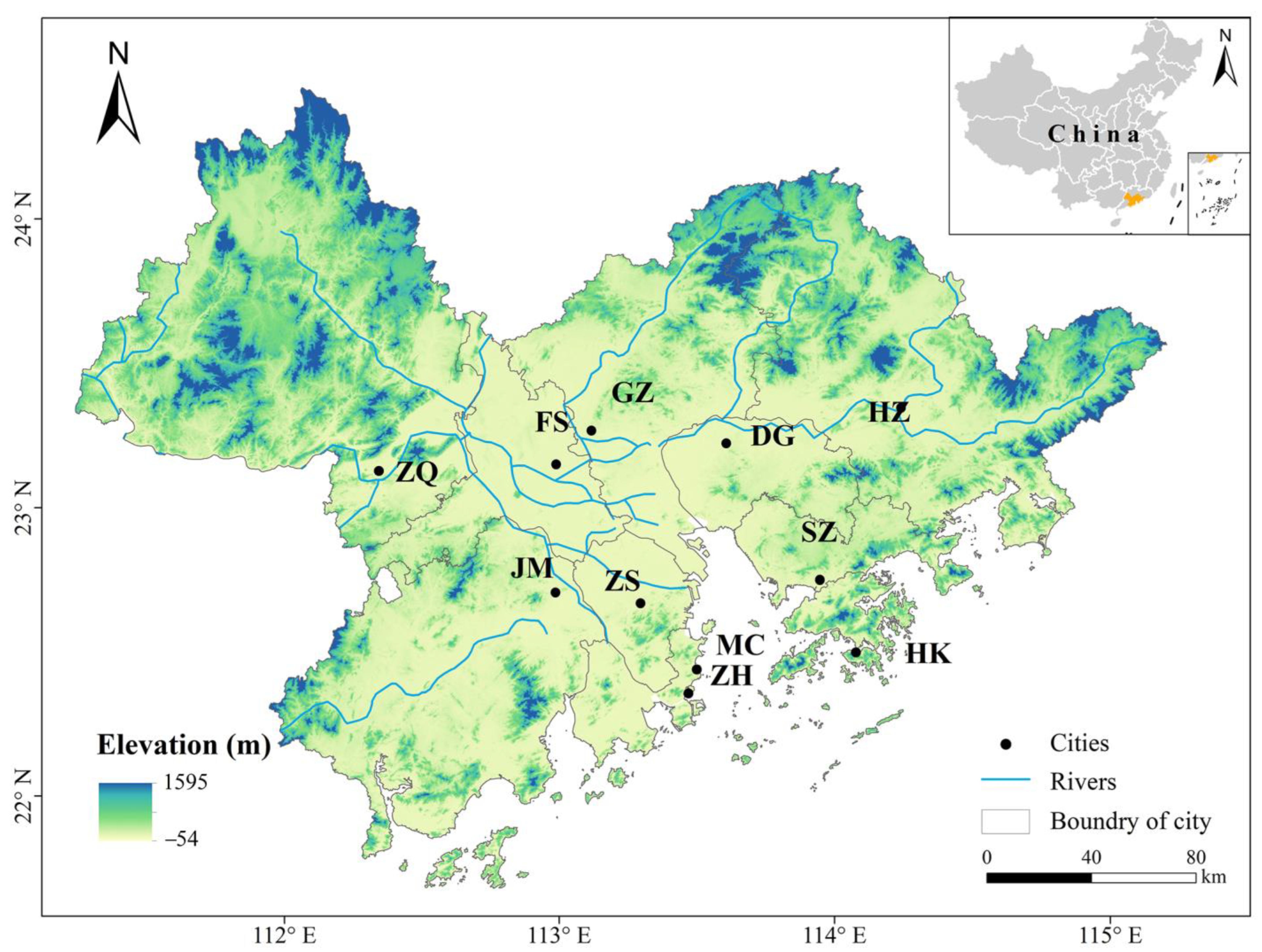



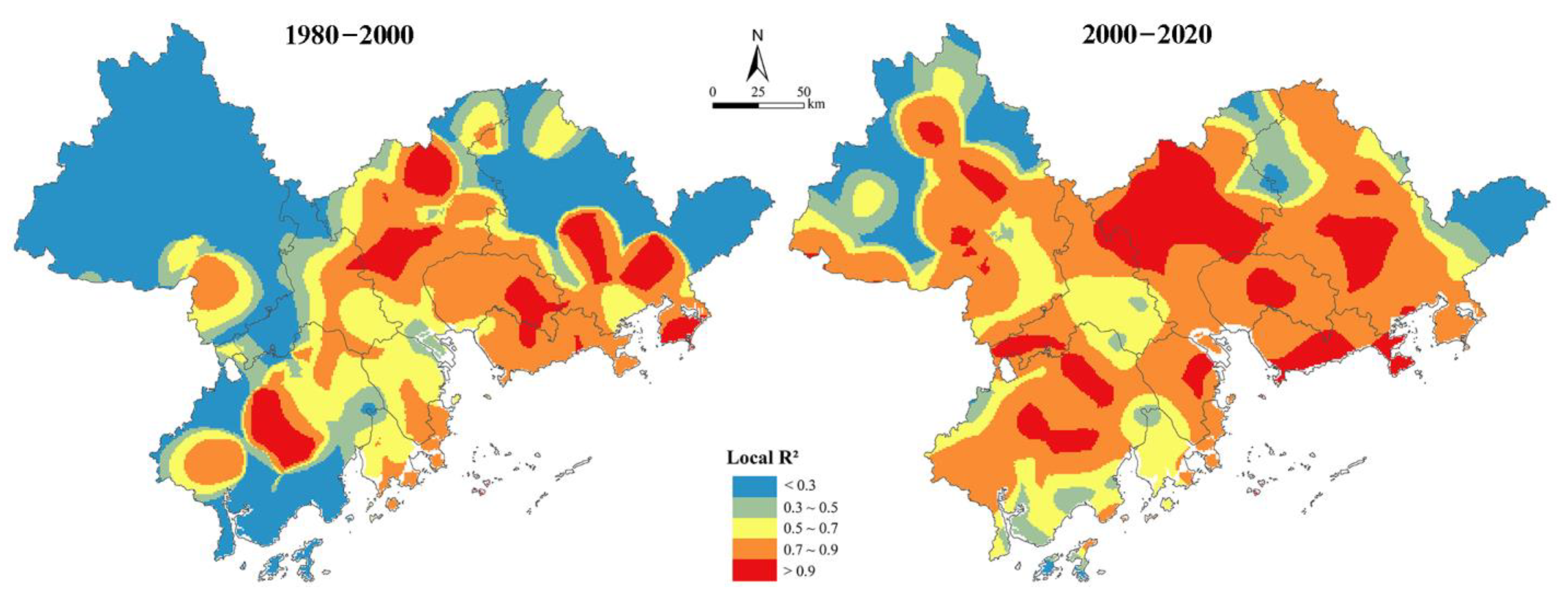




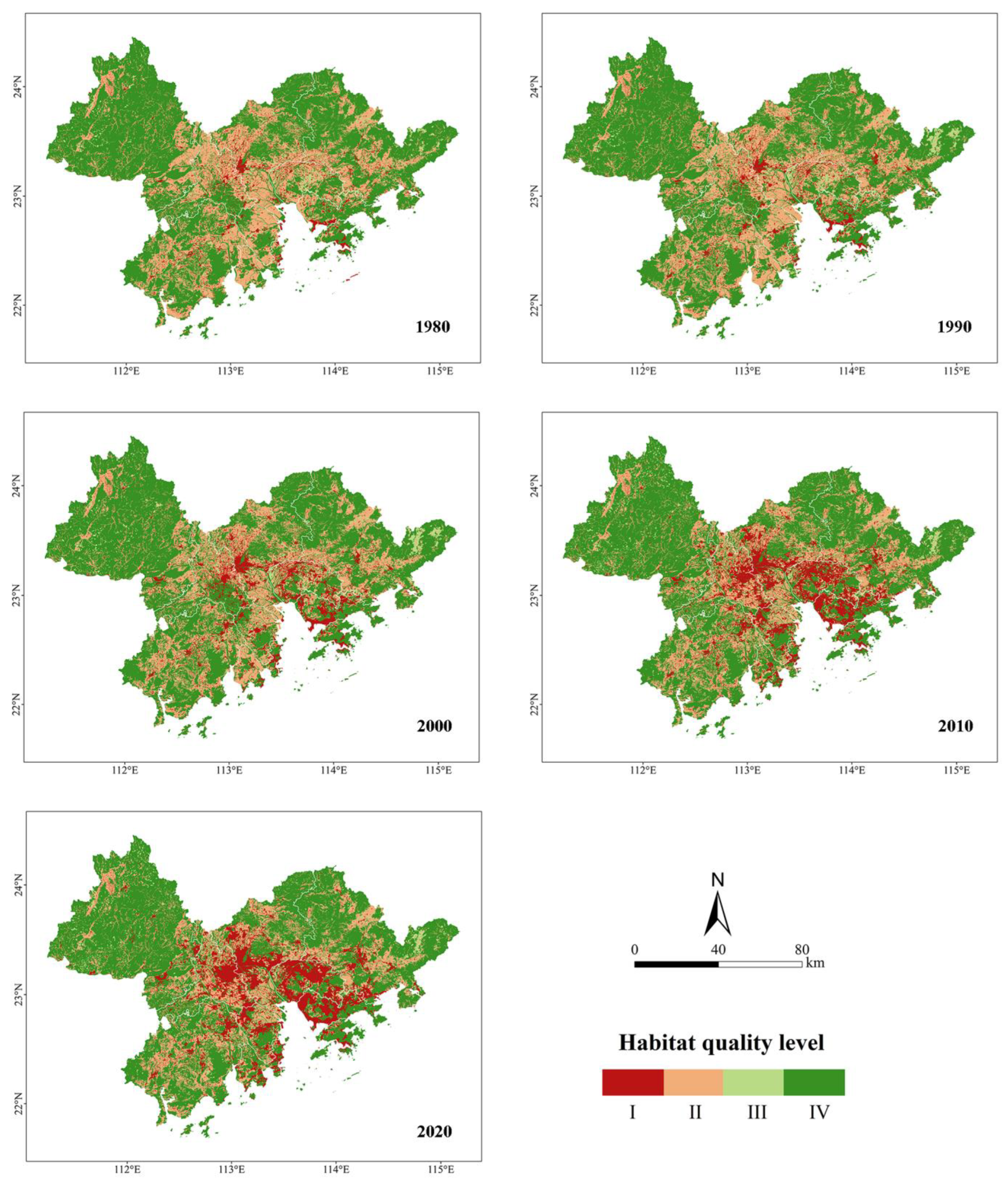

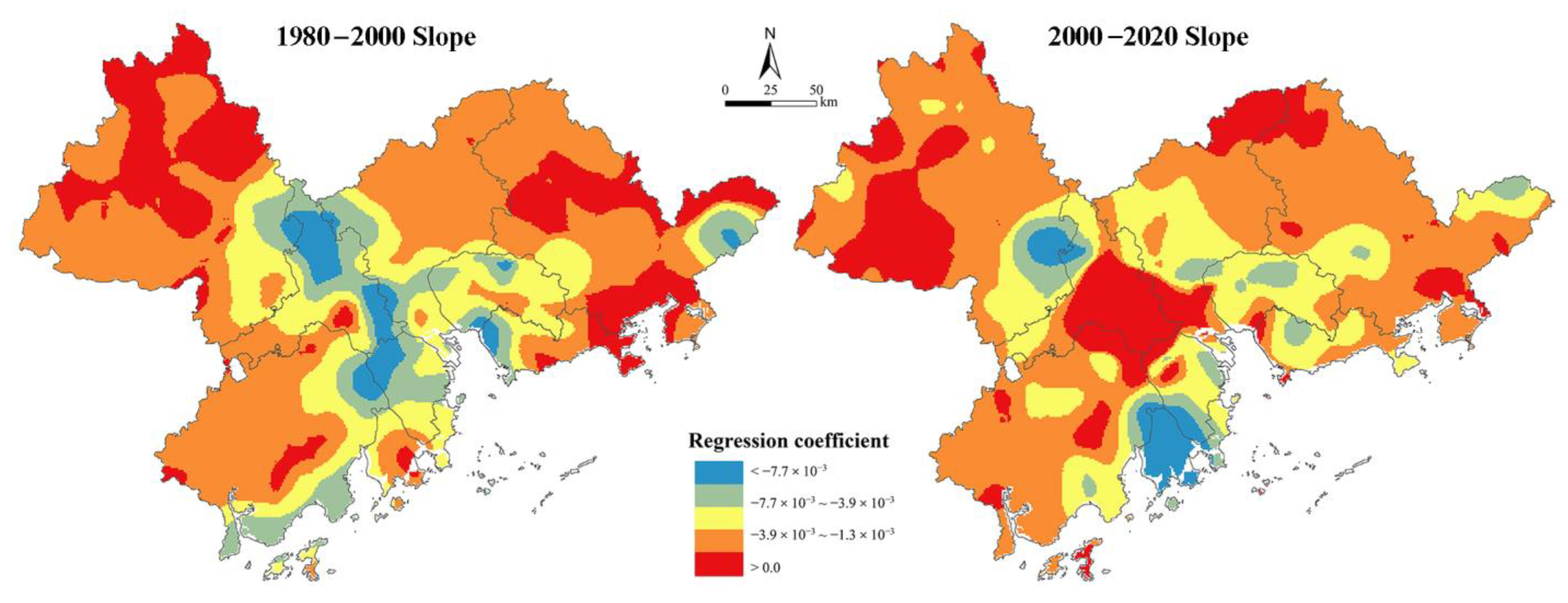
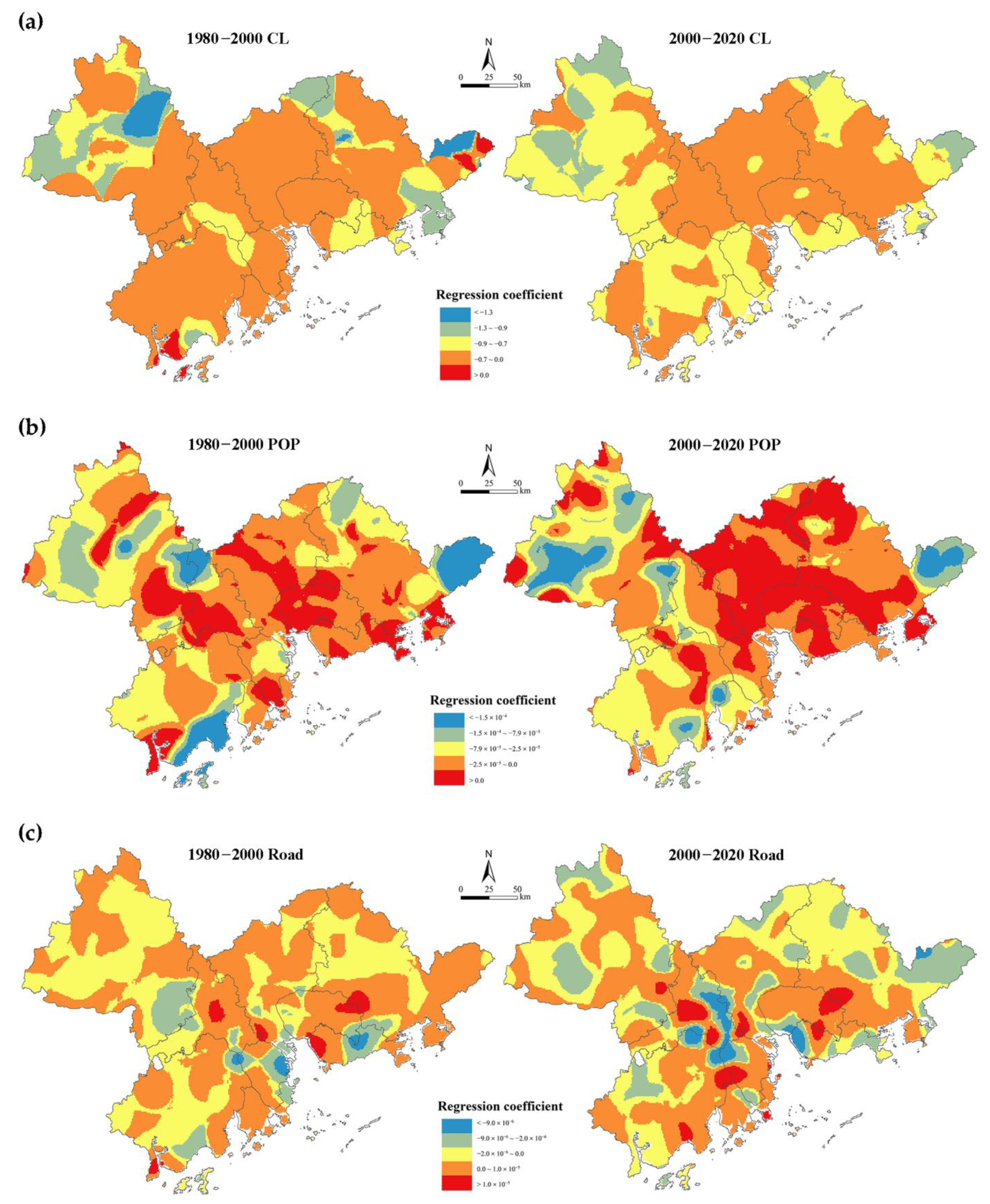
| Landscape Metrics | Formula | Description | |
|---|---|---|---|
| Class level | Number of patches (NP) | , where is the number of patches of type i | reflects the spatial pattern of a landscape and has a positive correlation with fragmentation. |
| Mean patch size (MPS) | , where is the area of patches of type i | ; the lower the value, the greater fragmentation of patch class. | |
| Largest path index (LPI) | , where is total area | refers to the ratio of the largest patch area to the total landscape area. Its value can characterize the dominance of a given landscape type. | |
| Landscape level | Patch density (PD) | , where is the is the total number of patches in the landscape | ; a higher value means more patches per unit area and greater fragmentation. |
| Perimeter-area fractal dimension (PAFRAC) | describes the complexity of the landscape. When the value tends to 1, it means that the patch shape is simple. | ||
| Aggregation index (AI) | , where is the number of similar neighboring patches of a given landscape type | examines the degree of clustering of classes within a landscape; the smaller the value, the higher the dispersion degree. | |
| Shannon’s diversity index (SHDI) | , where is the probability of the occurrence of landscape patch type i in the landscape | reflects the richness of each patch type within the landscape. |
| Threat Factors | Weight ωr | Distance-Decay Function | |
|---|---|---|---|
| CT | 8 | 0.5 | linear |
| UL | 10 | 1 | exponential |
| RS | 8 | 0.8 | exponential |
| OCL | 9 | 0.9 | linear |
| UL | 5 | 0.3 | exponential |
| Land Use Types | Suitability | CT | UL | RS | OCL | UL |
|---|---|---|---|---|---|---|
| CT | 0.5 | 0 | 0.7 | 0.5 | 0.6 | 0.3 |
| WL | 1 | 0.7 | 0.9 | 0.7 | 0.8 | 0.3 |
| SH | 1 | 0.6 | 0.8 | 0.6 | 0.7 | 0.2 |
| SP | 1 | 0.5 | 0.7 | 0.5 | 0.6 | 0.2 |
| OWL | 0.8 | 0.4 | 0.7 | 0.5 | 0.6 | 0.2 |
| GL | 0.9 | 0.5 | 0.8 | 0.7 | 0.8 | 0.4 |
| RV | 1 | 0.7 | 0.9 | 0.7 | 0.8 | 0.2 |
| LK | 1 | 0.7 | 0.9 | 07 | 0.8 | 0.2 |
| RE | 1 | 0.3 | 0.5 | 0.3 | 0.4 | 0.2 |
| TD | 1 | 0.8 | 1 | 0.8 | 0.7 | 0.2 |
| FA | 0.8 | 0.8 | 1 | 0.8 | 0.7 | 0.3 |
| UL | 0 | 0 | 0 | 0 | 0 | 0 |
| RS | 0 | 0 | 0 | 0 | 0 | 0 |
| OCL | 0 | 0 | 0 | 0 | 0 | 0 |
| UL | 0.3 | 0.3 | 0.5 | 0.4 | 0.5 | 0 |
| SA | 1 | 0.2 | 0.6 | 0.4 | 0.5 | 0.1 |
| Measuring Metrics | 1980–2000 | 2000–2020 | ||
|---|---|---|---|---|
| OLS | GWR | OLS | GWR | |
| Sigma | 0.057 | 0.050 | 0.072 | 0.056 |
| AICc | −152,720.269 | −167,632.616 | −128,410.083 | −154,192.882 |
| R2 | 0.683 | 0.765 | 0.778 | 0.867 |
| Radj2 | 0.683 | 0.762 | 0.778 | 0.865 |
| Period | Land Use Type | CT | FL | GL | WB | CL | UL |
|---|---|---|---|---|---|---|---|
| I (/km2) | CT | 15,424.87 | 292.76 | 16.25 | 401.83 | 473.60 | 2.29 |
| FL | 235.33 | 30,333.68 | 38.57 | 42.84 | 81.50 | 0.24 | |
| GL | 15.30 | 171.13 | 1211.75 | 4.42 | 6.54 | 0.04 | |
| WB | 120.37 | 41.31 | 4.51 | 3164.17 | 26.53 | 0.10 | |
| CL | 76.16 | 30.94 | 2.37 | 18.68 | 2466.51 | 0.02 | |
| UL | 45.98 | 6.61 | 0.21 | 77.86 | 11.27 | 12.14 | |
| II (/km2) | CT | 13,808.67 | 288.80 | 16.40 | 796.60 | 1015.63 | 0.41 |
| FL | 285.58 | 30,156.38 | 49.06 | 53.60 | 349.69 | 0.31 | |
| GL | 17.75 | 61.31 | 1151.30 | 4.76 | 38.82 | 0.11 | |
| WB | 153.71 | 51.91 | 3.90 | 3387.48 | 151.77 | 0.21 | |
| CL | 76.28 | 36.84 | 2.77 | 16.01 | 2934.92 | 0.01 | |
| UL | 0.25 | 0.62 | 0.09 | 0.12 | 0.01 | 14.54 | |
| III (/km2) | CT | 11,516.64 | 354.63 | 19.51 | 684.89 | 1766.25 | 0.27 |
| FL | 307.93 | 29,378.12 | 50.87 | 95.44 | 762.81 | 0.60 | |
| GL | 21.32 | 102.73 | 1019.86 | 14.06 | 65.53 | 0.05 | |
| WB | 576.60 | 68.89 | 7.34 | 3090.56 | 516.04 | 0.12 | |
| CL | 183.08 | 135.39 | 6.34 | 79.46 | 4106.61 | 0.07 | |
| UL | 2.33 | 1.02 | 0.10 | 0.42 | 4.44 | 7.22 | |
| IV (/km2) | CT | 11,404.05 | 203.63 | 21.65 | 186.64 | 790.19 | 0.14 |
| FL | 226.06 | 29,156.00 | 86.05 | 104.85 | 456.87 | 0.29 | |
| GL | 13.74 | 36.46 | 1011.18 | 7.39 | 33.87 | 0.03 | |
| WB | 102.37 | 67.58 | 12.33 | 3509.94 | 270.58 | 0.14 | |
| CL | 337.45 | 180.03 | 47.48 | 82.57 | 6572.97 | 0.02 | |
| UL | 0.42 | 0.30 | 0.05 | 0.18 | 1.49 | 6.17 |
| Indices | 1980 | 1990 | 2000 | 2010 | 2020 |
|---|---|---|---|---|---|
| PD | 0.459 | 0.464 | 0.473 | 0.503 | 0.444 |
| PAFRAC | 1.447 | 1.449 | 1.450 | 1.407 | 1.408 |
| SHDI | 1.112 | 1.117 | 1.167 | 1.204 | 1.220 |
| AI | 96.684 | 96.626 | 96.508 | 96.576 | 96.731 |
Disclaimer/Publisher’s Note: The statements, opinions and data contained in all publications are solely those of the individual author(s) and contributor(s) and not of MDPI and/or the editor(s). MDPI and/or the editor(s) disclaim responsibility for any injury to people or property resulting from any ideas, methods, instructions or products referred to in the content. |
© 2022 by the authors. Licensee MDPI, Basel, Switzerland. This article is an open access article distributed under the terms and conditions of the Creative Commons Attribution (CC BY) license (https://creativecommons.org/licenses/by/4.0/).
Share and Cite
Wang, X.; Su, F.; Yan, F.; Zhang, X.; Wang, X. Effects of Coastal Urbanization on Habitat Quality: A Case Study in Guangdong-Hong Kong-Macao Greater Bay Area. Land 2023, 12, 34. https://doi.org/10.3390/land12010034
Wang X, Su F, Yan F, Zhang X, Wang X. Effects of Coastal Urbanization on Habitat Quality: A Case Study in Guangdong-Hong Kong-Macao Greater Bay Area. Land. 2023; 12(1):34. https://doi.org/10.3390/land12010034
Chicago/Turabian StyleWang, Xinyi, Fenzhen Su, Fengqin Yan, Xinjia Zhang, and Xuege Wang. 2023. "Effects of Coastal Urbanization on Habitat Quality: A Case Study in Guangdong-Hong Kong-Macao Greater Bay Area" Land 12, no. 1: 34. https://doi.org/10.3390/land12010034






